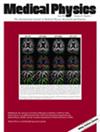Comparative image quality and dosimetric performance of two generations of dedicated breast CT systems
Abstract
Background
Dedicated breast computed tomography (bCT) systems offer detailed imaging for breast cancer diagnosis and treatment. As new bCT generations are developed, it is important to evaluate their imaging performance and dose efficiency to understand differences over previous models.
Purpose
To characterize the imaging performance and dose efficiency of a second-generation (GEN2) bCT system and compare them to those of a first-generation (GEN1) system.
Methods
The imaging performance was evaluated through key metrics: modulation transfer function (MTF), noise power spectrum (NPS), and detective quantum efficiency (DQE) in the projection domain. In the image domain, contrast-to-noise ratio (CNR), signal-to-noise ratio (SNR), and the visibility of calcifications were analyzed using a quality control (QC) phantom with masses and calcification clusters. Air kerma and tube output were measured and mean glandular dose (MGD) estimated for different phantom sizes for dosimetric characterization of the acquisition protocols set by the automatic exposure control (AEC).
Results
GEN2 outperformed GEN1 at higher spatial frequencies, with 57% of the MTF observed at 1 cycles/mm compared to 43% for GEN1. For a 2 mm diameter mass, GEN2 showed 60% higher CNR and 63% higher SNR. However, for larger masses, GEN1 outperformed GEN2, with CNR and SNR values higher by 12% to 44% and 14% to 43%, respectively. GEN2 also achieves higher DQE across the frequency spectrum, with 45% at 1 cycle/mm, compared to GEN1's 20%. Regarding calcifications in the QC phantom, the 320 µm calcifications resulted in distinct full-width-at-half-maxima (FWHM ± SD), with 897 ± 58 µm for GEN1 and 811 ± 127 µm for GEN2, with a p-value of 0.19. For 290 µm calcifications, GEN1's FWHM was 866 ± 129 µm, while GEN2's was narrower at 665 ± 57 µm, with a p-value of 0.01. The tube output was higher for GEN1 (45.2 mGy/mAs) compared to GEN2 (31.5 mGy/mAs). Additionally, GEN2 resulted in 8% lower MGD values compared to GEN1.
Conclusion
While GEN1 offers better CNR and SNR for larger masses, GEN2 provides superior resolution for calcifications, better MTF, improved DQE, and lower MGD at AEC-determined settings.


 求助内容:
求助内容: 应助结果提醒方式:
应助结果提醒方式:


